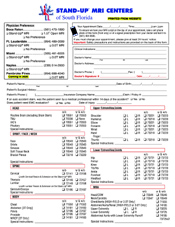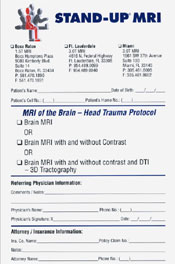SPINE,
(2009),
Volume 34, Number 23 2545-2550
“Dynamic Bulging of Intervertebral Discs in the Degenerative Lumbar Spine”
J. Zou, M.D. et al., Dept. of Orthopedic Surgery, UCLA & Dept. of Orthopedic Surgery, Soochow Univ.
“This study evaluated the use of the novel of... kinematic MRI in [513] patients with chronic lower back pain. Greater disc bulging under postural loading occurs with advancing degenerative disc disease. Prone extension is a posture commonly used in physical therapy. Based on our study, grade I discs displayed the expected response to dynamic positions. However, more degenerative discs behave less predictably, and extension may result in significant disc bulging. These results question the popular therapeutic techniques.” Read Complete Article
SPINE,
(2008),
Volume 33, Number 5 E140-E144
“Missed Lumbar Disc Herniations Diagnosed With Kinetic Magnetic Resonance Imaging”
J. Zou, M.D. et al., Dept. of Orthopedic Surgery, UCLA & Dept. of Orthopedic Surgery, Soochow Univ.
In a study of 553 patients with symptomatic back pain: “For patients with normal or less than 3 mm
bulge in neutral, 19.46% demonstrated an increase in herniation to greater than 3 mm in extension.”
Further, 15.29% demonstrated an increase in herniation to greater than 3 mm in flexion. Read Complete Article
Brain Injury,
(2010),
Volume 24 Number 7-8 988-994
“A Case-Controlled Study of Cerebellar Tonsillar Ectopia (Chiari) and Head/Neck Trauma (Whiplash)”
M Freeman et al., Oregon Univ. School of Medicine, Univ. of Aarhus, Univ. of Aberdeen, Spinal Injury Foundation, Columbia Univ. Dept. of Neurological Surgery, Univ. of Nebraska Medical Center, Wisconsin Chiari Center
A multi-center study of 1200 patients with neck pain showed recumbent MRI underestimates the
incidence of herniated cerebellar tonsils. The incidence of tonsillar herniation in non-traumatic neck pain
patients was about the same, 5.3-5.7%, for both recumbent and upright positions, while in whiplash
patients, 23.3% examined upright showed herniation of the cerebellar tonsils, whereas only 9.3% examined
recumbent showed this abnormality. Read Complete Article
Clinical Radiology,
(2008),
63, 1035-1048
“Upright Positional MRI of the Lumbar Spine”
F. Alyas, et. al., London Upright MRI Centre and Department of Radiology, Royal National Orthopaedic Hospital NHS Trust, Stanmore, Middlesex, UK
“there is no doubt that clinically relevant spinal canal stenosis can be uncovered by imaging the erect
position. In cases where conventional MRI shows no evidence of cauda equina or lumbar nerve root
compression in the setting of convincing clinical symptoms that warrant surgical intervention, re-imaging
in the upright position, with the addition of flexion and extension, is recommended.” Read Complete Article
Clinical MRI,
(2006),
Volume 15, Issue 3 [ESSR (2005) Oxford, England]
“Positional Upright Imaging of the Lumbar Spine Modifies the Management of Low Back Pain and Sciatica”
F.W. Smith, M.D. et al., Dept. of Radiology, University of Aberdeen, Scotland, UK
In a study of 25 patients with low back pain and sciatica referred to the Upright MRI for lumbar spine
MRIs following at least one prior “normal” recumbent MRI within 6 months of referral: “13 patients
(52%) demonstrated abnormalities in one or more of the seated postures that were not evident in the supine exam ... Each of the thirteen patients has undergone appropriate surgery and six months postsurgery
they remain symptom free.” Read Complete Article
Southern Medical Journal,
(2004),
“Dynamic Weight-Bearing Cervical Magnetic Resonance Imaging: Technical Review and Preliminary Results”
T. Vitaz, M.D. et al., Dept. of Neurological Surgery, University of Louisville School of Medicine
20 patients with symptoms consistent with radiculopathy or myelopathy were scanned upright in a GE
0.5T Signa SP system designed for MR image-guided surgery. “When only static supine MRI scanning is
performed on these patients, the true abnormality may be overlooked and inappropriate surgical plans
instituted because of a lack of illustration of the changes that occur with movement.” Read Complete Article
Knee,
(2010),
Elsevier
“Upright MRI in kinematic assessment of the ACL-deficient knee”
Nicholson JA, et al, University of Aberdeen, UK
A study of eight sequential patients with ACL deficiency. (and control group of five healthy volunteers)
“highlights the importance of upright weight-bearing with regards to pathological kinematic studies. We
propose that FFC [flexion facet centre technique] measurement in an upright, weight-bearing position is
a reliable and representative tool for the assessment of femoro-tibial movement.” Read Complete Article
 Adobe
Acrobat Reader is required to view PDF files. This is a free program available from the Adobe
web site or by clicking the link to the right.
Adobe
Acrobat Reader is required to view PDF files. This is a free program available from the Adobe
web site or by clicking the link to the right. 

